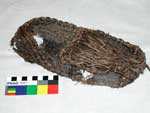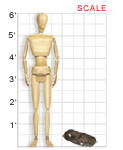From the collection of:
William S. Webb Museum of Anthropology || VAM Home
TWINED SLIPPER, Early Woodland Period, c. 1000-200 BCE
Red-Eye Hollow Rock Shelter, Lee County, Kentucky
Simple twined plant fiber; 26 cm. long, 10 cm. wide
Catalog Number 15LE1-T63
William S. Webb Museum of Anthropology, University of Kentucky
Dry rock shelter and cave sites in Kentucky, particularly in the Eastern mountains and the Mammoth Cave region, are known to preserve perishable fragments of textile and basketry, such as twined slippers, bags, and mats. Although these kinds of objects are extremely rare, the examples we do have indicate that prehistoric native peoples incorporated elaborate and artistic elements into everyday objects.
Footwear or slippers (not true moccasins) made of plant fiber are some of the most common prehistoric textiles found in these dry sites. Native weavers commonly made slippers by twining, which is a very simple form of weaving that does not require a loom. They commonly used a plant called rattlesnake master (Eryngium yuccifolium), which has tough, yucca-like leaves. With little preparation, the long, fibrous leaves were twined into a rectangular shape that was then drawn up around the foot and secured with a drawstring. In this image, the toe section is to the right, and the heel is to the left. The heel and the section across the ball of the foot have been worn out, much like what happens to modern socks. Different designs were woven into the tongue of each slipper, making it the most artistic element of the shoe.
Classroom Ideas
Discussion: Would you have known this was a slipper if you had found it in a rock shelter? How do you think archaeologists determined that this piece was used as footwear? What clues does the material this textile was woven from give you about where it was produced? Do you think this object qualifies as a work of art? Why or why not?
Activity: For many early cultures, weaving was an important aid to survival. Native Americans used this skill to produce blankets, clothing, and other textiles. What other skills would have been critical to know for survival 3,000 years ago? Make a list of skills that would be necessary or useful to North American natives. Would these skills have differed depending on a society’s location? How would life be different for inhabitants on the coast as opposed to a landlocked area? How would it differ from northern to southern areas of America? Include an explanation of how the skills you listed would be necessary or helpful to early peoples.
Links
Read the article Prehistoric Textiles at the Stone Site, Stewart County, Tennessee from the Frank H. McClung Museum.
[mcclungmuseum.utk.edu/research/renotes/rn-04txt.htm]
The Native American Technology and Art web site includes information about the weaving and cordage of textiles.
[www.nativetech.org/weave/]
Learn more about Kentucky archaeological sites and discoveries at the Kentucky Archaeological Survey web site.
[www.kyheritage.org/kas.htm]
Find out about how and why the USDA Forest Service maintains heritage sites in the Heritage Resources section of the Daniel Boone National Forest web site.
[www.fs.fed.us/r8/boone/heritage/]
See the William S. Webb Museum of Anthropology site for lots of teaching resources, including information about time periods, online activities, and lesson plans.
[www.uky.edu/AS/Anthropology/Museum/museum.htm]

